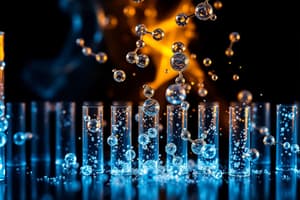Podcast
Questions and Answers
Which trend is observed in the physical properties of alkali metals as you move down the group?
Which trend is observed in the physical properties of alkali metals as you move down the group?
- Melting points increase
- Electrical conductivity increases (correct)
- Densities decrease
- Atomic radii decrease
Which of the following describes a chemical property of alkali metals?
Which of the following describes a chemical property of alkali metals?
- They are less reactive than alkaline earth metals
- They oxidize slowly in air
- They do not react with water
- They react with halogens to form ionic compounds (correct)
How does the reactivity of alkali metals change as you go down the group?
How does the reactivity of alkali metals change as you go down the group?
- Reactivity increases (correct)
- Reactivity remains constant
- Reactivity is unpredictable
- Reactivity decreases
When an alkali metal reacts with water, what type of product is typically formed?
When an alkali metal reacts with water, what type of product is typically formed?
Which balanced equation correctly represents the reaction of sodium with water?
Which balanced equation correctly represents the reaction of sodium with water?
Flashcards
Electrical Conductivity of Alkali Metals
Electrical Conductivity of Alkali Metals
The ability of a material to conduct electricity increases as you move down the group in the periodic table.
Chemical Property of Alkali Metals
Chemical Property of Alkali Metals
A chemical property describes how a substance reacts with other substances.
Reactivity of Alkali Metals
Reactivity of Alkali Metals
The tendency of alkali metals to react with other substances becomes stronger as you move down the group.
Reaction of Alkali Metals with Water
Reaction of Alkali Metals with Water
Signup and view all the flashcards
Balanced Equation for Sodium and Water
Balanced Equation for Sodium and Water
Signup and view all the flashcards
Study Notes
Trends in Physical Properties
- Alkali metals (Group 1 elements: Li, Na, K, Rb, Cs, Fr) are characterized by low densities, with the first three (Li, Na, K) being less dense than water.
- They exhibit a shiny, metallic luster when freshly cut, but tarnish rapidly due to oxidation.
- Melting and boiling points decrease as atomic number increases, resulting in lower values for heavier metals.
- Alkali metals are highly malleable and ductile, easily deformed under pressure.
Chemical Properties
- Alkali metals are highly reactive, particularly with water, resulting in the formation of hydroxides and hydrogen gas.
- Reactivity increases down the group; Li reacts less violently, while Cs reacts explosively with water.
- They readily lose one electron to form +1 cations, making them strong reducing agents.
- They can react with halogens to form ionic salts, exemplified by reactions with chlorine to produce metal chlorides.
Trends in Reactivity
- Reactivity increases down the group as the outer electron is further from the nucleus, making it easier to lose.
- The shielding effect increases with more electron shells, leading to lower ionization energies, thus enhancing reactivity.
- Lithium shows the least reactivity, while francium is the most reactive but is highly radioactive and rare.
Balanced Equations for Reactions
- Reaction with water:
( 2 \text{M} + 2 \text{H}_2\text{O} \rightarrow 2 \text{MOH} + \text{H}_2 ) (where M represents an alkali metal) - Reaction with halogens:
( 2 \text{M} + \text{X}_2 \rightarrow 2 \text{MX} ) (where X is a halogen, e.g., Cl, Br) - Combustion in air:
( 4 \text{M} + \text{O}_2 \rightarrow 2 \text{M}_2\text{O} )
Studying That Suits You
Use AI to generate personalized quizzes and flashcards to suit your learning preferences.





